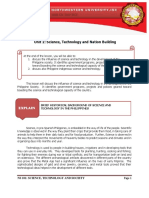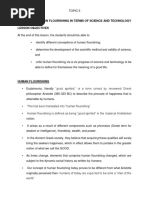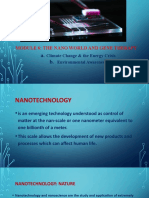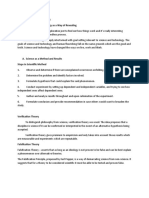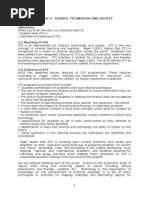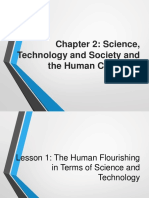Chapter 3 Nation Building
Chapter 3 Nation Building
Uploaded by
Ally CapacioCopyright:
Available Formats
Chapter 3 Nation Building
Chapter 3 Nation Building
Uploaded by
Ally CapacioOriginal Description:
Original Title
Copyright
Available Formats
Share this document
Did you find this document useful?
Is this content inappropriate?
Copyright:
Available Formats
Chapter 3 Nation Building
Chapter 3 Nation Building
Uploaded by
Ally CapacioCopyright:
Available Formats
CHAPTER 3: SCIENCE, TECHNOLOGY, AND NATION-BUILDING
I. INTRODUCTION
II. BRIEF HISTORICAL BACKGROUND OF SCEINCE AND TECHNOLOGY IN THE PHILIPPINES
III. GOVERNMENT POLICIES
IV. FAMOUS FILIPINOS IN THE FIELD OF SCIENCE
I. INTRODUCTION
This lesson will discuss the influence of science and technology in the development of the Philippine society.
It identifies government programs, projects, and policies geared toward boasting the science and technological
capacity of the country. The Philippines is trying its best to improve the state of science education in the country.
II. BRIEF HISTORICAL BACKGROUND OF SCEINCE AND TECHNOLOGY IN THE PHILIPPINES
The history of science and technology in the Philippines started way back before the country gained its
independence from the American colonizers. Before the coming of the Spaniard colonizers, the early inhabitants
of the archipelago had their own culture and traditions. They had their own beliefs and indigenous knowledge
system that keeps them organized and sustained their lives and communities.
A. Science- Pre Spanish Philippines
It is embedded in the way of life of the people
Scientific knowledge is observed in the way they plant their crops that provide them food; In taking care
of animals to help them in their daily tasks, and for food production.
Science is observed in the way they interpret the movements of heavenly bodies to predict seasons and
climates, and in organizing days into months and years.
They use science in preparing the soil for agricultural purposes and like any other ancient cultures, they
discovered the medicinal uses of plants.
Technology
It is used by people in building houses, irrigations, and in developing tools that they can use in everyday
life.
They developed tools for planting, hunting, cooking, and fishing; for fighting their enemies during war or
tribal conflicts; and for transportation, both on land and on water ways.
They also developed technologies in creating musical instruments.
The different archaeological artifacts discovered in different parts of the country also prove that the Metal Age also
had a significant influence on the lives of early Filipinos.
The sophisticated designs of gold, and silver jewelry, ceramics, and metal tools proved that their
technological ideas helped in the development of different tools.
Also, trading with China, Indonesia, Japan, and other nearby countries have influenced their lives by
providing different opportunities for cultural and technological exchange.
Note: All these ancient practices in science and technology are considered now as indigenous science or folk science.
B. Science and Technology during Spanish Period
When Spaniards colonized the country, they brought with them their own culture and practices. They
established schools for boys and girls and introduced the concept of subjects and disciplines.
CHAPTER 3; SCIENCE, TECHNOLOGY, AND NATION-BUILDING:
PREPARED BY: M.G.G.GREGANDA 1
Learning of science in school focuses on understanding different concepts related to the human body,
plants, animals, and heavenly bodies.
Technology focuses on using and developing house tools used in everyday life.
Life during this period became modernized, adapting some Western technology and their ways of life.
The Filipinos developed ways to replicate the technology brought by the Spaniards using indigenous
materials.
Medicine and advanced science were introduced in formal colleges and universities established by the
Catholic orders.
The galleon trade has brought additional technology and development in the Philippines. These trades
allowed other ideas, crops, tools, cultural practices to reach the country. Some Filipino students who were
able to study in Europe also contributed to the advancement of medicine, engineering, arts , music, and
literature in the country.
Philippines was considered to be one of the developed places in the region because of being one of the
centers of global trade, though superstitious beliefs of the people and the Catholic doctrines and
practices during the Spanish era halted the growth of Science in the country.
C. Science and Technology during the American Period
The Americans have more influence in the development of science and technology in the Philippines
compared during the Spaniards.
They established the public educational system.
Improved the engineering works and the health conditions of the people.
They established a modern research university, the University of the Philippines.
Created more public hospitals than the former colonial master.
The mineral resources of the country were also explored and exploited during the American times.
Transportation and communication system were improved, though not accessible throughout the country.
The Americans did everything to “Americanize” the Philippines. They recognized the learning of Science
and introduced it in public and private schools.
In basic education, science education focuses on nature studies and science and sanitation, until it
became a subject formally as “Science”
The teaching of Science in Higher education has also greatly improved and modernized.
Researches were done to control malaria, cholera, and tuberculosis and other tropical diseases.
The Protestants church missions, introduced new knowledge in different places in the country also
brought hospitals and schools to far-flung areas. Little by little, these efforts built a stronger foundation for
science and technology in the country.
D. Science and Technology During World War II
Has destabilized the development of the country in many ways.
Institutions and public facilities were turned into ashes, houses were burned, and many lives were
destroyed.
CHAPTER 3; SCIENCE, TECHNOLOGY, AND NATION-BUILDING:
PREPARED BY: M.G.G.GREGANDA 2
The country had a difficult time to rebuild itself from the ruins of the war. The human spirit may be strong
but the capacity of the country to bring back what was destroyed was limited
The reparation funds focused on building some institutions and public facilities like schools, hospitals. And
transportations systems.
The reparation money from Japan was also concentrated on building highways and in providing
technological training and human resource development in the country.
E. Science and Technology During the New Republic
The whole nation has been focusing on using its limited resources in improving its science and technological
capability.
It has explored the use of ODA or Overseas development Allocations from different countries to help the
country improve its scientific productivity and technological capability.
Human resource development is at the heart of these efforts focusing on producing more engineers,
scientists, technology experts, doctors, and other professionals in the country.
Generally, the development of science and technology in the Philippines based on the brief history, is
shaped by several factors and influences. It is always shaped by human and social activities, both internal
and external.
Internal Influences
Survival
Culture Development of
Economic Science and
Activities Technology in the
Philippines
External Influences
Foreign Colonizers
Trades with Foreign
Countries
International Economic
demands
Figure 1. Influences in the Development of Science and technology in the Philippines
III. GOVERNEMENT POLICIES ON SCIENCE AND TECHNOLOGY
The Philippine government introduced and implemented several programs, projects, and policies to boost the
area and science and technology. The goal is to prepare the whole country and its people to meet the demands of a
technologically driven world and capacitate the people to live in a world driven by science.
Padilla –Concepcion (2015) reported that in 2015, in response to the ASEAN 2015 Agenda, the government,
particularly the Department of Science and technology (DOST) has sought the expertise of the National Research Council
CHAPTER 3; SCIENCE, TECHNOLOGY, AND NATION-BUILDING:
PREPARED BY: M.G.G.GREGANDA 3
of the Philippines (NCRP) to consult various sectors in the society to study how the Philippines can prepare itself in meeting
the ASEAN 2015 Goals. As a result of the consultation, the NCRP is expected to recommend policies and programs that will
improve the competitiveness of the Philippines in the ASEAN Region.
The NCRP clustered these policies into Four, Namely:
1. Social Sciences, Humanities, Education, International Policies and Governance
Integrating ASEAN awareness in basic education without adding to the curriculum
Emphasizing teaching in the mother tongue
Developing school infrastructure and providing ICT broadband
Local food security
2. Physics, Engineering and Industrial Research, Earth and Space Sciences, and Mathematics
Emphasizing degrees , licenses, and employment opportunities
Outright grants for peer monitoring
Review of RA 9184
Harnessing science and technology as an independent mover of development
3. Medical, Chemical, and Pharmaceutical Sciences
Ensuring compliance of drug-manufacturing firms with ASEAN-harmonized standards by full implementation
of the food and drug Administration
Creating an education council dedicated to standardization of pharmaceutical services and care
Empowering food and drug agencies to conduct evidence-based research as pool of information
Allocating two percent of the GDP to research
Legislating a law supporting human genome projects
4. Biological Sciences, Agriculture, and Forestry
Protecting and conserving biodiversity by full implementation of existing laws
Use of biosafety and standard model by ASEAN countries
Promoting indigenous knowledge systems and indigenous people’s conservation
Formulation of common food and safety standards
There are also other existing programs supported by the Philippine government through the DOST. Some of these
projects are the following:
Providing funds for basic research and parents related to science and technology. The government funds
basic and applied researches. Funding of these research and projects are also from the Overseas
Development Aid (ODA) from different countries.
Providing scholarships for undergraduate and graduate studies of students in the field of science and
technology. Saloma (2015) pointed out that the country needs to produce more doctoral graduates in the
field of science and technology, and produce more research in these fields, including engineering.
Establishing more branches of the Philippine Science High School System for training young Filipinos in the
Field or science and technology.
Creating science and technology parks to encourage academe and industry partnerships.
CHAPTER 3; SCIENCE, TECHNOLOGY, AND NATION-BUILDING:
PREPARED BY: M.G.G.GREGANDA 4
Balik Scientist Program to encourage Filipino scientists abroad to come and work in the Philippines or
conduct research and projects in collaboration with Philippine-based scientists.
Developing science and technology parks in academic campuses to encourage academe and industry
partnerships.
The establishment of the National Science Complex and National Engineering Complex within the University
of the Philippines campus in Diliman.
o These aimed to develop more science and technology and engineering manpower resources
needed by the country.
o Also aimed to produce more researches in these fields.
The Philippine –American Academy of Science and Engineering (PAASE, 2008) identified several capacity-building
programs such as:
Establishment of national centers of excellence
Manpower and institutional development programs, such as the Engineering and Science Education
Program (ESEP) to produce more PhD graduates in science and engineering.
Establishment of regional centers to support specific industries that will lead the country in different
research and development areas.
Establishment of science and technology business centers to assist, advise, and incubate
technopreneurships ventures
Strengthen science education at an early age through the Philippine Science High School System.
In the field of education, several science-related programs and projects were created to develop the scientific
literacy of the country. Special science classes were organized and special elementary schools were established in
different regions. Aside from these, science and mathematics in basic education were continuously improved. The
current K to 12 education program included Science, Technology, Engineering, and Mathematics (STEM) as one of
its major tracks in the senior high school program to encourage more students to enrol in science-related fields in
college.
Lately, the Commission on Higher Education launched its Philippine-California Advanced Research Institute
(PICARI) Project to allow several higher education institution in the Philippines and some US based laboratories,
research and projects related to science, agriculture, engineering, health, and technology. This project is hoped to
strengthen the STEM competitiveness of the country.
There are many other areas and fields that the country is looking forward to embark various research
projects. The following are some of them:
1. Use of alternative and safe energy
2. Harnessing mineral resources
3. Finding cure for various diseases and illness
4. Climate change and global warming
5. Increasing food production
6. Preservation of natural resources
7. Coping with natural disaster and calamities
CHAPTER 3; SCIENCE, TECHNOLOGY, AND NATION-BUILDING:
PREPARED BY: M.G.G.GREGANDA 5
8. Infrastructure development
The Philippine Congress has also created various laws related to science and technology. These law serve
as a legal framework for science and technology in the country. These laws vary according to different themes such as:
Conservation
Health-related
Technology-building and
Supporting basic research among others.
Some laws and policies are in line with international treaties such as:
1. United Nations (UN)
2. United Nations Educational, Scientific and Cultural Organization (UNESCO)
3. Association of Southeast Asian Nations (ASEAN) and
4. Other International agencies
National Goals
International Treaty
SCIENCE AND TECHNOLOGY
Policies
Programs
Projects
Legal Frameworks
Social Needs, Issues, and
Problems
Figure 2. Development of Science and technology Policies in the Philippines
As shown in the diagram, the development of policies in science and technology is shaped or influenced by
several variables: policies need to be aligned to national goals, consider international commitments based on legal
frameworks, and respond to various social needs, issues, and problems. Science and technology policies ensure
that the whole country and all people will experience the progress that science can bring. Policies are guides to
direct all efforts to a goal of developing a scientifically advanced country.
IV. FAMOUS FILIPINOS IN THE FIELD OF SCIENCE
School science is filled with names of foreign scientists: Einstein, Galileo Galilei, Newton, Faraday, and many
Other Western scientists. Lee-Chua (2000) identified 10 outstanding Filipino scientists who have made significant
contributions in Philippine science. These scientists are also famous abroad especially in different science disciplines;
agriculture, mathematics, physics, medicine, marine science, chemistry, engineering, and biology.
CHAPTER 3; SCIENCE, TECHNOLOGY, AND NATION-BUILDING:
PREPARED BY: M.G.G.GREGANDA 6
These Filipino scientists are:
1. Ramon Cabanos Barba – for his outstanding research on tissue culture in Philippine mangoes
2. Josefino Cacas Comiso – for his works on observing the characteristics of Antarctica by using satellite images
3. Jose Bejar Cruz Jr. – known internationally in the field of electrical engineering; was elected as officer of the famous
Institute of Electrical and Electronic Engineering.
4. Lourdes Jansuy Cruz – notable for her research on sea snail venom
5. Fabian Millar Dayrit – for his research on herbal medicine
6. Rafael Dineros Guerrero III – for his research on tilapia culture
7. Enrique Mapua Ostrea Jr. – for inventing the meconium drug testing
8. Lilian Formalejo Parena – for doing research on plant biotechnology
9. Mari-Jo Panganiban Ruiz – for being an outstanding educator and graph theorist
10. Gregory Ligot Tangonan – for his research in the field of communications technology
There are other outstanding Filipino scientists who are recognized here and abroad for their outstanding
contributions in science:
1. Caesar A. Saloma – an internationally renowned physicist
2. Edgardo Gomez – famous scientist in marine science
3. William Padolino – chemistry and president of National Academy of Science and Technology (NAST)- Philippines
4. Angel Alcala – marine science
There are other scientist in the Philippines who were not identified in the list.
The University of the Philippines – Los Banos is a science paradise for agriculture, forestry, plant and
animal science, and veterinary science.
The University of the Philippines - Visayas is also national center for marine science, fisheries, and other
related sciences.
The University of the Philippines – Manila is a center of excellence and has produced may researchers,
doctors, health professionals, and scientists in the area of medical and public health.
The University of the Philippines- Diliman also has established a national science and engineering complex
to develop more research and produce more scientists and engineers in the country.
Many of these Filipino scientists are products of good school science. It means they were taught and
Inspired by great teachers. Their interests in science started to manifest during their childhood years. Their natural
environment ignited their curiosity to learn more about the natural and physical environment. Schools and the laboratories
where they studied and worked nurtured this.
CHAPTER 3; SCIENCE, TECHNOLOGY, AND NATION-BUILDING:
PREPARED BY: M.G.G.GREGANDA 7
Individual Interests in
Science
School Science SCIENCE LABORATORIES
Family
(TEACHERS AND (REAL-LIFE CONTEXT)
LEARNING ENVIRONMENT
Natural Environment
FILIPINO SCIENTISTS
Figure 3. Factors that Influence the Development of Filipino Scientists
Many Filipino scientists, whether they are in the country or abroad, always excel in their job. They continue to bring
honor to the country. They make ordinary things in an extraordinary way. They are always at par with other scientists in
spite of the limited facilities we have here in the country.
SUMMARY:
Even before the time of Spanish colonization in the Philippines, various people and communities already practiced
science. They invented tools and built structures, studied the medical uses of plants, observed heavenly bodies to predict
seasons and weather, and used indigenous science in agriculture. These are considered indigenous science, which one of
the foundations of modern science.
The growth of science and its development as a field in the country is a hybrid of indigenous and foreign ideas.
Spain and the United States, being the former colonial masters of the country, played an important role in building the
foundation of science in the Philippines. To further strengthen the science program in the Philippines, the government
establishes various programs, policies, and projects.
Through the years, many Filipinos were able to establish themselves as scientists and science educators in various
scientific areas and fields. Inventions and innovations were done by these Filipino Scientist. Finally, the demands of
globalization, especially the ASEAN economic agenda, prompted the Philippines to invest in science and technology
programs and projects.
References:
McNamara, Daniel Joseph SJ, Vida Mia Valverde, and Beleno, Ramon III, Science, Technology, and Society (2018), C& E
Publishing, Inc., EDSA, South Triangle, Quezon City
Serafica, Janice Patria J, Greg T. Pawilen et.al, Science , Technology, and Society, First Edition (2018), REX Bookstore,
Manila, Philippines.
CHAPTER 3; SCIENCE, TECHNOLOGY, AND NATION-BUILDING:
PREPARED BY: M.G.G.GREGANDA 8
CHAPTER 3; SCIENCE, TECHNOLOGY, AND NATION-BUILDING:
PREPARED BY: M.G.G.GREGANDA 9
You might also like
- Test Bank Managerial Accounting Decision Making and Motivating Performance 1st Edition Datar and Rajan PDFDocument9 pagesTest Bank Managerial Accounting Decision Making and Motivating Performance 1st Edition Datar and Rajan PDFAlly CapacioNo ratings yet
- Historical Antecedents in Which Social Considerations Changed The Course of Science and TechnologyDocument47 pagesHistorical Antecedents in Which Social Considerations Changed The Course of Science and TechnologyMariel C. Segador100% (3)
- Science Technology and Nation BuildingDocument30 pagesScience Technology and Nation BuildingMARIA100% (3)
- Science, Technology, & SocietyDocument11 pagesScience, Technology, & SocietyChad BroskiNo ratings yet
- Chapter 3 Intellectual Revolutions That Defined Society STSDocument40 pagesChapter 3 Intellectual Revolutions That Defined Society STSAylie Pilobello100% (3)
- Science and Technology and The Nation-BuildingDocument7 pagesScience and Technology and The Nation-BuildingKclyn Remolona100% (3)
- Science Technology and Nation BuildingDocument4 pagesScience Technology and Nation BuildingCholophrex SamilinNo ratings yet
- Science and Technology and Nation Building: Learning Experiences & Self-Assessment Activities (Saa)Document15 pagesScience and Technology and Nation Building: Learning Experiences & Self-Assessment Activities (Saa)Rofil Albao100% (2)
- Science Technology and Nation BuildingDocument33 pagesScience Technology and Nation BuildingDeanne Jean David100% (1)
- Science and Technology and Nation Building Sts Presentation 2-3 WeeksDocument60 pagesScience and Technology and Nation Building Sts Presentation 2-3 WeeksJay Albaytar100% (1)
- GEC 8 Packet 1Document47 pagesGEC 8 Packet 1Jean MojadoNo ratings yet
- The Good Life StsDocument36 pagesThe Good Life StsRaianne Keith TabingNo ratings yet
- STS Cradles of Early ScienceDocument41 pagesSTS Cradles of Early ScienceMark Vincent Z. PadillaNo ratings yet
- Learning Activity 1 - Human FlourishingDocument2 pagesLearning Activity 1 - Human FlourishingManoj Mudiraj100% (2)
- Chap 2.science, Technology and Nation BuildingDocument20 pagesChap 2.science, Technology and Nation Buildingkeen vNo ratings yet
- Module1 PDFDocument46 pagesModule1 PDFMark Kevin Clyde Quitoras100% (1)
- Module 5 The Human Person Flourishing in Terms of Science and TechnologyDocument6 pagesModule 5 The Human Person Flourishing in Terms of Science and TechnologyCharice Anne VillamarinNo ratings yet
- Sts ReportingDocument27 pagesSts ReportingFranchezca B.100% (1)
- Human Flourishing in Science and TechnologyDocument84 pagesHuman Flourishing in Science and TechnologyAndromeda Galaxy100% (2)
- Module 6: The Nano World and Gene Therapy: Climate Change & The Energy Crisis Environmental AwarenessDocument59 pagesModule 6: The Nano World and Gene Therapy: Climate Change & The Energy Crisis Environmental AwarenessAllan Gabriel UmaliNo ratings yet
- STS Report Human FlourishingDocument26 pagesSTS Report Human Flourishingjhell de la cruzNo ratings yet
- The Good LifeDocument10 pagesThe Good LifeErric Torres100% (1)
- 3.module in Science Technology& SocietyDocument12 pages3.module in Science Technology& SocietyBainaot Abdul SumaelNo ratings yet
- STS Module 2 - Lesson 2Document3 pagesSTS Module 2 - Lesson 2jjjjjemNo ratings yet
- CHAPTER VI - When Technology and Humanity CrossDocument5 pagesCHAPTER VI - When Technology and Humanity CrossKeanno0% (1)
- Lesson 1 Intellectual Revolutions That Defined SocietyDocument50 pagesLesson 1 Intellectual Revolutions That Defined SocietyJayvee Precilla Malabanan70% (10)
- General Concepts and Historical DevelopmentsDocument29 pagesGeneral Concepts and Historical DevelopmentsJames ReyNo ratings yet
- Human Person Flourishing in Terms of Science and TechnologyDocument14 pagesHuman Person Flourishing in Terms of Science and TechnologyDee EmNo ratings yet
- Module 3 - Science Education in The PhilippinesDocument6 pagesModule 3 - Science Education in The PhilippinesDanylyn Sampere100% (1)
- Technology As A Way of RevealingDocument41 pagesTechnology As A Way of RevealingJaneth Miguel SatrainNo ratings yet
- STS MidtermDocument14 pagesSTS MidtermSUHARTO USMAN100% (2)
- Human FlourishingDocument60 pagesHuman Flourishingkakimog738100% (1)
- Science, Technology, and Society (STS) Hand-Out#6: Human FlourishingDocument5 pagesScience, Technology, and Society (STS) Hand-Out#6: Human FlourishingKclyn Remolona100% (1)
- Cradles of Early ScienceDocument24 pagesCradles of Early ScienceMichelle MalabananNo ratings yet
- 5 6.2. Major Development Programs and Personalities in S T in The PhilippinesDocument19 pages5 6.2. Major Development Programs and Personalities in S T in The PhilippinesRoma Lee Macababat100% (2)
- Lesson No. 2 Ancient, Middle and Modern AgesDocument19 pagesLesson No. 2 Ancient, Middle and Modern AgesMerryl Ibañez100% (2)
- Chapter 1 Science Technology and SocietyDocument65 pagesChapter 1 Science Technology and SocietyAylie Pilobello100% (3)
- The Philippine Government Science & Technology AgendaDocument28 pagesThe Philippine Government Science & Technology AgendaBJ A. Isidro100% (1)
- Module 3 Science Technology Society and The Human ConditionDocument5 pagesModule 3 Science Technology Society and The Human ConditionJay100% (1)
- Famous Filipinos in The Field of ScienceDocument4 pagesFamous Filipinos in The Field of ScienceJustin MagnanaoNo ratings yet
- Why The Future Does Not Need UsDocument15 pagesWhy The Future Does Not Need Ushope100% (1)
- STS - Chapter - 1 LESSON 1 PDFDocument34 pagesSTS - Chapter - 1 LESSON 1 PDFRhandel John ResiduoNo ratings yet
- Emalou Moleta STS Chapter 2 Lesson 1 Human FlourishingDocument4 pagesEmalou Moleta STS Chapter 2 Lesson 1 Human Flourishingarman magbagoNo ratings yet
- 4 STS-MODULE-8 Info AgeDocument8 pages4 STS-MODULE-8 Info AgeRose Vee Payno100% (1)
- Chapter 1 Science Technology SocietyDocument4 pagesChapter 1 Science Technology SocietyValerie Zara Alexius100% (5)
- STS First Year Second Sem 1Document11 pagesSTS First Year Second Sem 1Andrea Nicole De Leon100% (1)
- Chapter 2 - Science, Technology and The Human ConditionDocument47 pagesChapter 2 - Science, Technology and The Human ConditionDalene Evangelio100% (2)
- Lesson 2 - SCIENCE, TECHNOLOGY, AND NATION-BUILDINGDocument6 pagesLesson 2 - SCIENCE, TECHNOLOGY, AND NATION-BUILDINGJermaine Gonzales100% (2)
- STS PrelimDocument5 pagesSTS PrelimGomez Agustin LeslieNo ratings yet
- Unit I - General Concepts and Science Technology and Society Historical Developments OverviewDocument49 pagesUnit I - General Concepts and Science Technology and Society Historical Developments OverviewChristine Joyce MagoteNo ratings yet
- The Human Person Flourishing in Terms of Science and TechnologyDocument12 pagesThe Human Person Flourishing in Terms of Science and TechnologyJamaica M DanguecanNo ratings yet
- Human Person Flourishing in Science and TechnologyDocument68 pagesHuman Person Flourishing in Science and TechnologyEloisa Beltran Abquina100% (2)
- (SCIENCE) Activity 2 - Historical Antecedents in The Course of Science and TechnologyDocument4 pages(SCIENCE) Activity 2 - Historical Antecedents in The Course of Science and TechnologyLasona, Jojie I.No ratings yet
- Module 2 Science, Technology, and Society and The: Topic No.1 Technology As A Way of RevealingDocument2 pagesModule 2 Science, Technology, and Society and The: Topic No.1 Technology As A Way of RevealingAllan IgbuhayNo ratings yet
- Powerpoint 2 (Historical Antecedents)Document30 pagesPowerpoint 2 (Historical Antecedents)Xia Allia100% (1)
- STS Information SocietyDocument30 pagesSTS Information Societyedgar malupeng50% (2)
- Science Technology and Nation Building PDFDocument37 pagesScience Technology and Nation Building PDFceanime x ML75% (4)
- STS Reviewer 1Document5 pagesSTS Reviewer 1Dos por dosNo ratings yet
- STS - Lesson 4 Part IDocument17 pagesSTS - Lesson 4 Part ISUHARTO USMANNo ratings yet
- STS Prelim Chapter 1Document14 pagesSTS Prelim Chapter 1Veronica DyNo ratings yet
- STS Chapter 3Document15 pagesSTS Chapter 3Chrisbelle Jenn Apaling SawadanNo ratings yet
- Chapter 13Document104 pagesChapter 13Ally CapacioNo ratings yet
- SEC Memorandum Circular No 5Document4 pagesSEC Memorandum Circular No 5Ally CapacioNo ratings yet
- STS Textbook PDFDocument56 pagesSTS Textbook PDFAlly CapacioNo ratings yet
- Chapter 13Document104 pagesChapter 13Ally CapacioNo ratings yet
- Orca Share Media1582627496295 PDFDocument34 pagesOrca Share Media1582627496295 PDFAlly CapacioNo ratings yet
- Partnership 1767 1799Document24 pagesPartnership 1767 1799Ally CapacioNo ratings yet
- Estate Taxation TestbankDocument54 pagesEstate Taxation TestbankAlly Capacio100% (1)
- RFBT 8612 (1-24)Document24 pagesRFBT 8612 (1-24)Ally CapacioNo ratings yet
- PRTC LawDocument16 pagesPRTC LawAlly CapacioNo ratings yet
- Code of Ethics For AccountantsDocument49 pagesCode of Ethics For AccountantsAlly CapacioNo ratings yet






